Skyjelly
Skyjellies were gas-filled protozoans that floated high through the sky.

The first stage of a skyjelly’s life cycle was as an egg-like spore sac. The sac eventually broke open underwater, with hundreds of microscopic baby skyjellies flooding out. Skyjelly babies were weak and easy prey for larger fish and other aquatic fauna, but the surviving jellies soon grew outgrew these predators and filled up with gases that helped them float just above the waterline. Here, up to 2 meters above the water, Skyjellies would float for nearly half their lives. As they floated there, they hung tendrils deep into the water, angling for nutrients and plankton. They would grow larger and larger, developing an ovary pouch within the middle of their body which housed 3 to 5 spore sacs. Eventually, skyjellies would drop the egg sacs into the ocean, starting the life cycle anew. The mature protozoans, now with the weight of their offspring shed, drifted high into the sky, moving wherever the winds blew them.
Often times skyjellies landed in farmers’ fields and village streets near the ocean. Once disconnected from a source of water, skyjellies’ membranous skin began to dry, dissolving bit by bit until their internal gases leaked out and they lost flight. On the ground, it would be mere hours before the skyjelly is but a tiny pool of sludge. Villagers in certain regions set wide baskets or buckets up to catch these falling protozoa for food, especially in towns like Sharkville and Icthy’s Rest.
Also see the larger, magical predator cousins of skyjellies, Inuzumatako.